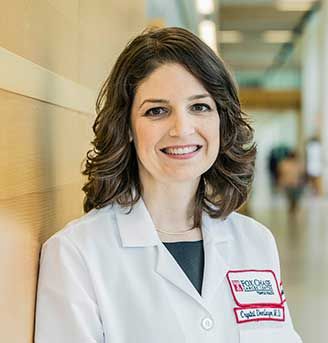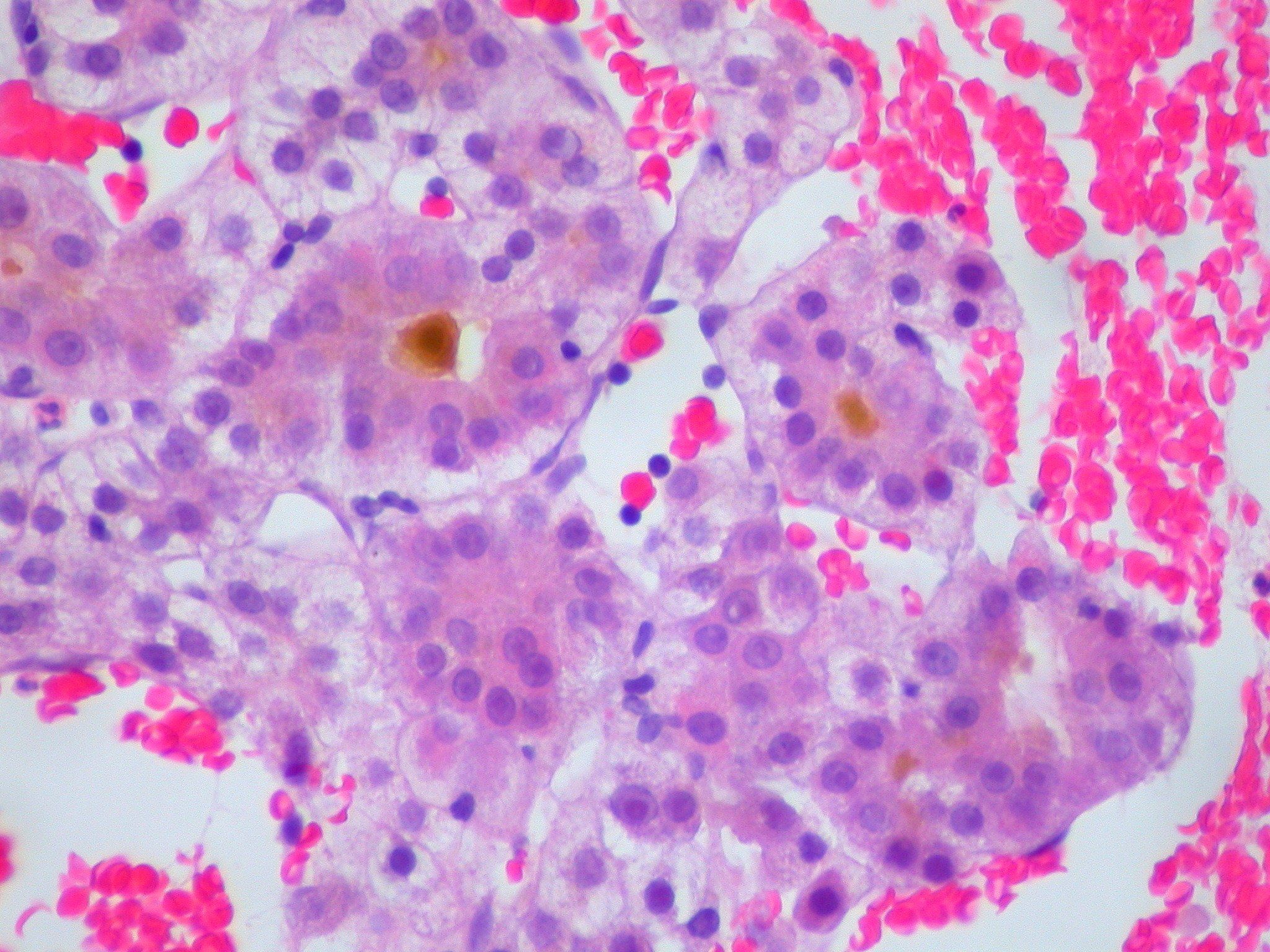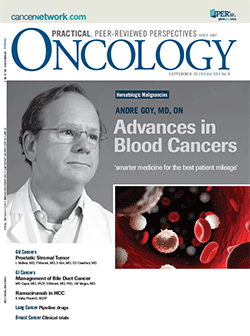Therapy Options for Patients With Hepatocellular Carcinoma
Therapy options for patients with hepatocellular carcinoma (HCC), including a newly approved therapy for a subpopulation of patient.
Crystal Denlinger, MD, FACP

Hepatocellular Carcinoma, FNA Clot Section

ONCOLOGY recently discussed therapy options for patients with hepatocellular carcinoma (HCC), including a newly approved therapy for a subpopulation of these patients, with Dr. Crystal S. Denlinger, an Associate Professor of Hematology and Oncology and the Chief of the Division of Gastrointestinal Medical Oncology at the Fox Chase Cancer Center in Philadelphia. Dr. Denlinger specializes in the care and treatment of patients with liver cancers, gastroesophageal cancers, and gall bladder and bile duct cancers.
Q: First, what is HCC, how frequent is it, and are there other types of liver cancer besides HCC?
Dr. Denlinger: HCC is a cancer that arises from the hepatocytes, the primary cells of the liver. It typically arises in the setting of other chronic liver diseases. It is a cancer that is on the rise. Actually, both incidence and mortality are rising, and it is now the fifth leading cause of cancer deaths in men and the seventh leading cause of cancer deaths in women.[1] There are a number of risk factors associated with liver cancer including hepatitis B virus, hepatitis C virus, alcoholic cirrhosis, and fatty liver disease and nonalcoholic fatty liver disease. As we get better at treating the viral hepatitis causes like hepatitis B and hepatitis C with antiviral therapy, we anticipate that fatty liver disease is going to become a leading cause of HCC in the future.[2]
There are other cancers that are considered to be liver cancers, including primary bile duct cancers, that are treated with other cytotoxic therapies. There are also some varieties of HCC, like fibrolamellar HCC, that have a different biology and treatment paradigm. We are focusing on the most common form of HCC.
Q: What are the therapy options for earlier-stage HCC? Is this cancer potentially curable at these earlier stages?
Dr. Denlinger: It is a potentially curable cancer at the earlier stage. We know that for patients who are at risk for HCC, screening is important because it can identify patients with potentially curable disease. Cirrhosis is a known risk factor and increases the incidence by 2% to 4% annually. So, screening with an abdominal ultrasound in high-risk patients can identify patients with early-stage disease for whom curative therapy is possible. For patients who have a small HCC with preserved liver function, we can ablate these tumors or we can surgically resect them with high rates of a cure. We know that for patients who do have surgical resection, survival is greater than 60% at 5 years. However, surgical resection or ablation in someone who has cirrhosis does carry with it a risk of tumor recurrence in up to 70% of patients at 5 years. For patients who have known cirrhosis and a small HCC, we can consider liver transplantation because that cures not only the liver cancer but also potentially the underlying hepatic cirrhotic disease.
There are criteria for who can get a liver transplant. We follow the Milan criteria, defining patients who have one tumor that is 5 cm or less in size or three tumors each no more than 3 cm in size as transplant candidates. If you see a patient who has a tumor that fits within the Milan criteria, early referral to a liver transplant program is paramount because they can be listed for transplant and then potentially cured of not only their cancer but also their liver disease. Survival in someone who meets Milan criteria and undergoes a liver transplant is associated with a 60% to 80% survival at 5 years and about 50% survival at 10 years, with a very low rate of tumor recurrence. Ablation can also be used for very small tumors that are under 2 cm in size in a good location within the liver. So, there are curable options for early-stage disease. Unfortunately in the United States, we do not commonly see patients with early-stage curable disease and many of the patients present with more advanced disease
Q: What about metastatic disease, what are the standard therapy options and how have these options evolved over the last few years?
Dr. Denlinger: For metastatic disease, there are a number of options and two groups of patients in whom palliative therapy can be very helpful. Patients with intermediate-stage disease, who may have multiple tumors within the liver but no disease outside of it, can be treated with chemoembolization or radioembolization. This is where we deliver either chemotherapy or radiation therapy directly into the liver and can also embolize off the blood supply to that tumor to control multifocal disease within the liver. For patients with advanced disease, who have disease outside of the liver or for whom liver-directed therapy is not an option for a variety of reasons, there are a number of systemic therapies for the treatment of liver cancer.[3] Until recently, we only had one drug, sorafenib, which was approved in 2007. Sorafenib was approved for patients with preserved liver function and advanced disease for whom liver-directed therapy is not an option. It was shown to improve survival by about 2.7 months compared to best supportive care and to control disease in about 50% to 60% of patients. More recently, we have developed additional drugs in the frontline setting.
There is a new drug called lenvatinib that has been shown to be noninferior to sorafenib in terms of survival with a slightly better disease control rate. We also now have second-line therapeutic options in the form of regorafenib, cabozantinib, nivolumab, pembrolizumab, and ramucirumab. Regorafenib, cabozantinib, and ramucirumab have all demonstrated survival benefit compared to best supportive care. Nivolumab and pembrolizumab have demonstrated survival benefit compared to historical controls. So, we have a number of drugs now in first- and second-line therapy for advanced cancer patients with good liver function.
Q: In May 2019, the US Food and Drug Administration (FDA) approved ramucirumab for patients previously treated for HCC, including with sorafenib, and who have alpha-fetoprotein (AFP) levels of 400 ng/mL or greater. This is the first therapy targeted for a specific subpopulation of patients with HCC that has been approved. Can you talk about this AFP biomarker and what it means in terms of the biology of HCC?
Dr. Denlinger: AFP is a protein that is made by the HCC. It has been used as a marker of diagnosis and also prognostication, and it used to be part of the diagnostic screening criteria for patients with liver cancer. Liver cancer is the only cancer that can actually be diagnosed without a biopsy based on radiographic criteria alone. Older diagnostic criteria also required an elevated AFP. That has since been removed from the diagnostic criteria because it is not a validated biomarker for hepatocellular cancers.
That being said, it is a poor prognostic marker, meaning that patients who have high AFP levels do have lower long-term survival and worse survival outcomes compared to patients who have lower AFP levels. We think that it may be associated with a marker of more advanced disease or disease that has higher angiogenic activity. This may be why AFP was a marker that was associated with better outcomes in the ramucirumab studies, because ramucirumab is a drug that targets angiogenesis and AFP is associated with highly angiogenic tumors. Then targeting angiogenesis in this subpopulation makes sense and could actually be associated with better outcomes.
Q: Finally, are there drugs or combination therapies for HCC now in development, either early or late stage, that have particularly interesting targets or a combination that is showing signs of efficacy that you could highlight?
Dr. Denlinger: This is a great time to be a doctor who treats HCC because there is a lot of research right now looking at not only new therapies but also combination therapies, which is wonderful because HCC didn't have any positive trials for 10 years. We had tons of negative studies. So, in addition to the recent FDA approvals and the large phase III trials that demonstrated survival benefit, there are now earlier-phase studies showing promise for combination therapies where you're combining an antiangiogenic therapy with an immunotherapy. There are studies looking at lenvatinib combined with immune checkpoint inhibitors, bevacizumab combined with immune checkpoint inhibitors, and cabozantinib combined with immune checkpoint inhibitors. Combining these antiangiogenic therapies with immune checkpoint Inhibitors is one potential avenue of research that looks very promising where response rates are higher than what we see with antiangiogenic therapy alone or immunotherapy alone. Also, combining multiple immune therapies together and targeting different components of the immune pathways seems very promising. There are studies looking at combining PD-1 or P-L1 inhibitors with other targeted immunotherapies in the hope that targeting the immune pathways through two different mechanisms may increase the chances of response and/or prolong survival. [3]
There are a lot of different options now, and we have a lot of clinical trials that are enrolling patients with Child- Pugh Score A liver function in the hope we'll be able to define a better treatment paradigm compared to what we currently have with single agents. We do have many needs for HCC patients. One of those unmet needs is therapeutic options for the non-Child-Pugh A patients. Many of our patients come to us with Child-Pugh Score B or Child-Pugh Score C disease, meaning that their liver function is not well compensated or is decompensated. In Child-Pugh Score C patients, therapy is not typically given because we know that the liver function is not going to be able to support it. But for the Child-Pugh Score B patients in whom liver function may be compromised because of disease burden and not necessarily because of underlying cirrhosis, we need more studies and data on how to use these drugs, how effective these drugs might be, and in what sequence to use them. So, there̢۪s an active research interest in looking at these agents in the non-Child-Pugh Score A population. Some data suggest that the therapies for HCC may have similar relative benefit in non-Child-Pugh Score A patients, but we need further data, especially with these newer agents, to really see how they perform.
Key Question
Where do you see ramucirumab fitting into the treatment scheme besides those who have AFP levels of at least 400 ng/mL? Are there certain patient characteristics that make them more suitable for this therapy in terms of tolerating treatment and in terms of efficacy?
Dr. Denlinger: For most of my patients who received sorafenib or lenvatinib up front and progress on it or who have intolerance to it, ramucirumab remains an option for those who have preserved liver function and a high AFP. I do talk about this drug with my patients as one option for the second line. The decision about whether to use this medication versus one of the other oral medications is based on the patient's preference regarding intravenous versus oral therapies, as well as their tolerance to the previous and antiangiogenic tyrosine kinase inhibitors that they received. Ramucirumab has a very different side-effect profile from cabozantinib and regorafenib, in that it doesn't have the hand–foot toxicities and some of the anorexia, weight loss, and appetite toxicities associated with these other medications.
Ramucirumab is certainly a reasonable treatment option in the second line. One of the most important things that we have to think about in liver cancer is the underlying liver function. So, we will not only assess how much disease the patient has but also their underlying hepatic function based on the Child-Pugh Score. Child-Pugh Score A patients have typically been the patients for whom all of the drugs we talked about earlier have been tested. The ramucirumab studies initially enrolled patients with Child-Pugh Score A and Child-Pugh Score B. During the first ramucirumab trial called the REACH trial, it was found that for Child-Pugh Score B patients, there were higher rates of adverse liver function-associated events compared to the placebo arm and enrollment of Child-Pugh Score B patients was stopped.[4] Therefore, it's important with ramucirumab, but actually with all antiangiogenic agents, to ascertain the liver function of the patient. For ramucirumab specifically, it's important to restrict use of this drug to patients with Child-Pugh Score A, because we don't want to exacerbate hepatic dysfunction in patients with more advanced cirrhosis.
For most of my patients who received sorafenib or lenvatinib up front and progress on it or who have intolerance to it, ramucirumab remains an option for those who have preserved liver function and a high AFP. I do talk about this drug with my patients as one option for the second line. The decision about whether to use this medication versus one of the other oral medications is based on the patient's preference regarding intravenous versus oral therapies, as well as their tolerance to the previous and antiangiogenic tyrosine kinase inhibitors that they received. Ramucirumab has a very different side-effect profile from cabozantinib and regorafenib, in that it doesn't have the hand-foot toxicities and some of the anorexia, weight loss, and appetite toxicities associated with these other medications. So, if a patient has a really difficult time on sorafenib or lenvatinib with respect to hand-foot syndrome or other side effects, ramucirumab might be a good alternative in some because it typically does not have those same side effects.
Financial Disclosures:Dr. Denlinger has received grants or research support from Astex Pharmaceuticals, Bayer HealthCare, ImClone Systems Incorporated, MedImmune Inc., Merrimack Pharmaceuticals, OncoMed Pharmaceuticals, and Pfizer Inc., and has served as a scientific advisor for Eli Lilly and Company.
PERSPECTIVE

New Therapeutic Options for Patients with Hepatocellular Carcinoma
Richard S. Finn, MD
In the past two years, we have seen quite a few new drugs approved for hepatocellular carcinoma (HCC), particularly in the second line setting. We now have phase 3 data demonstrating a role for sorafenib and lenvatinib in the front-line setting and for regorafenib, cabozantinib, and ramucirumab in the second-line setting, as well as pembrolizumab in this setting as well. Both pembrolizumab and nivolumab received accelerated approval for second-line HCC. Ramucirumab is a monoclonal antibody against human monoclonal antibody against vascular endothelial growth factor receptor 2 (VEGFR2). The drug is unique in being the first drug approved for HCC based on a biomarker for patient selection, that is those with an elevated alpha fetoprotein (AFP≥ ng/mL). The data initially showing that ramucirumab could work in this select patient population was from a second line clinical trial that did not meet its overall survival primary endpoint in the entire study population but the retrospective analysis showed that those patients with a high AFP in the control arm did poorly and that those patients with a high AFP received a significant improvement in survival in the ramucirumab arm. Subsequently, the REACH-2 phase 3 study evaluated this hypothesis and was the basis for the approval of ramucurimab by the Food and Drug Administration. This study enrolled only those patients with an elevated AFP demonstrated a survival benefit for that population. There are patients who have high AFP since their diagnosis and there are patients who have a rising AFP as their disease advances. Both patients appear to benefit from ramucirumab. The other approved agents work in this subpopulation of patients as well but what is advantageous about ramucirumab is that its side effect profile is different from that of the tyrosine kinase inhibitors (TKIs) and is tied to its activity against the VEGF receptor, including hypertension and proteinuria. Recently, a phase 3 study with the PD-1 monoclonal antibody pembrolizumab showed a relatively high response rate and those that responded had a long disease control rate and increased overall survival but the results did not reach the pre-specified statistical criteria for being considered a positive clinical trial. However, pembrolizumab is an important drug for managing patients with HCC. In this context, my strategy is to expose patients to as many active drugs, sequentially, in the course of their disease. A patient that is progressing quickly through their first line advanced HCC therapy with a TKI may be a better candidate for a second-line immunotherapy such as pembrolizumab to have a chance at the durable and deep responses that have been seen. Ramucirumab is a good option for patients with high AFP who experienced toxicities while on a TKI and are in need of a break from those side effects. Given the newer therapy options, we are still figuring out how to best sequence these therapies, including ramucirumab, for our patients with HCC. With all of these new options, it is imperative that we start patients on systemic treatments when there disease advances, before their liver function starts to decompensate.
Financial Disclosures:Dr. Finn has been a consultant for AstraZeneca, Bristol Myers Squibb, Eli Lilly, Merck, Novartis, Pfizer, Roche, and Genentech.
Dr. Finnis an Oncologist and Assistant Professor of Medicine at the Geffen School of Medicine at UCLA, Department of Medicine, Division of Hematology/Oncology, Santa Monica, California.
Disclosures:
References:
1. American Cancer Society. Cancer Facts & Figures 2019. Available at: https://www.cancer.org/research/cancer-facts-statistics/all-cancer-facts-figures/cancer-facts-figures-2019.html Accessed September 3, 2019.
2. Balogh J, Victor D 3rd, Asham EH, et al. Hepatocellular carcinoma: a review. J Hepatocell Carcinoma. 2016;3:41-53.
3. Grieb BC, Goff LW, Goyal L, Denlinger CS. Evolving landscape of systemic therapy for hepatocellular carcinoma: breakthroughs, toxicities, and future frontiers. Am Soc Clin Oncol Educ Book. 2019;39:248-60.
4. Raoul JL, Frenel JS, Raimbourg J, Gilabert M. Current options and future possibilities for the systemic treatment of hepatocellular carcinoma. Hepat Oncol. 2019;6:HEP11.
